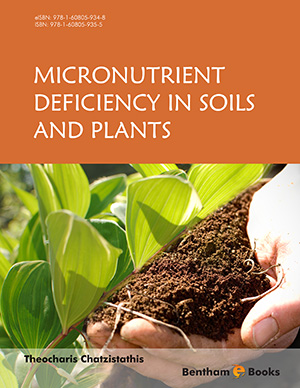Abstract
The average concentration of Mo in the lithosphere is 2.4 mg/kg and in soils varies greatly, depending on parent material. Molybdenum solubility, thus its’ availability for plants, is affected by many factors, such as soil pH, organic matter, the content of Fe oxides/hydroxides in soils, P concentration, liming, crop management, soil humidity and interactions with other nutrients. Molybdenum is mainly absorbed as MoO42- and it is readily and highly mobile in xylem and phloem. The form by which Mo is translocated is probably that of MoO4-. From the physiological functions of Mo, the most important is that in atmospheric N capturing and uptake. Particularly, nitrogenase and nitrate reductase, which are involved in N fixation and NO3- reduction respectively, are Mo-containing enzymes and their activity is depressed under conditions of Mo deficiency. Apart from the involvment of Mo in nitrogen metabolism and fixation, Mo also participates in N transport in plants, as well as it occurs in more than 60 enzymes and catalyzes diverse oxidation and reduction reactions. Furthermore, Mo is also involved in processess concerning the synthesis of the phytohormones abscisic acid and indole-3 butyric acid.
Generally, Mo foliar level 0.5 p.p.m. is considered for most plant species as critical deficient, while for some others may be lower, for example 0.1 or 0.3 p.p.m. Molybdenum deficiency symptoms include deep chlorosis of old leaflets, spreading to young growth and intensification of chlorosis leading to bleaching. The leaf chlorosis of Mo deficiency somewhat resembles to that of N deficiency, due in part to Mo role in N utilization. In order to detect Mo deficiency before the appearance of symptoms, induciable nitrate reductase activity can be used as an indicator of the Mo nutritional status of plants, since Mo is an essential component of two major enzymes (nitrate reductase and nitrogenase). Finally, in order to correct Mo starvation, Mo can be supplied either in mixtures as fertilizers, or as seed coating, or foliar sprays of watersoluble Mo salts, mostly ammonium and sodium molybdates.
All the points referring to Mo availability in soils, its’ uptake, the physiological roles of Mo in plant metabolism, the critical Mo concentrations, the symptoms of deficiency and the methods used for its’ detection, as well as the Mo-fertilizers used to alleviate Mo stress in crops, are fully analyzed and discussed in this chapter.
Keywords: Mo adsorption, Mo availability, Mo deficiency, Mo fertilizers, Mo uptake, N capturing, N fixation, Nitrate reductase, Nitrogenase, NO3 reduction.






















